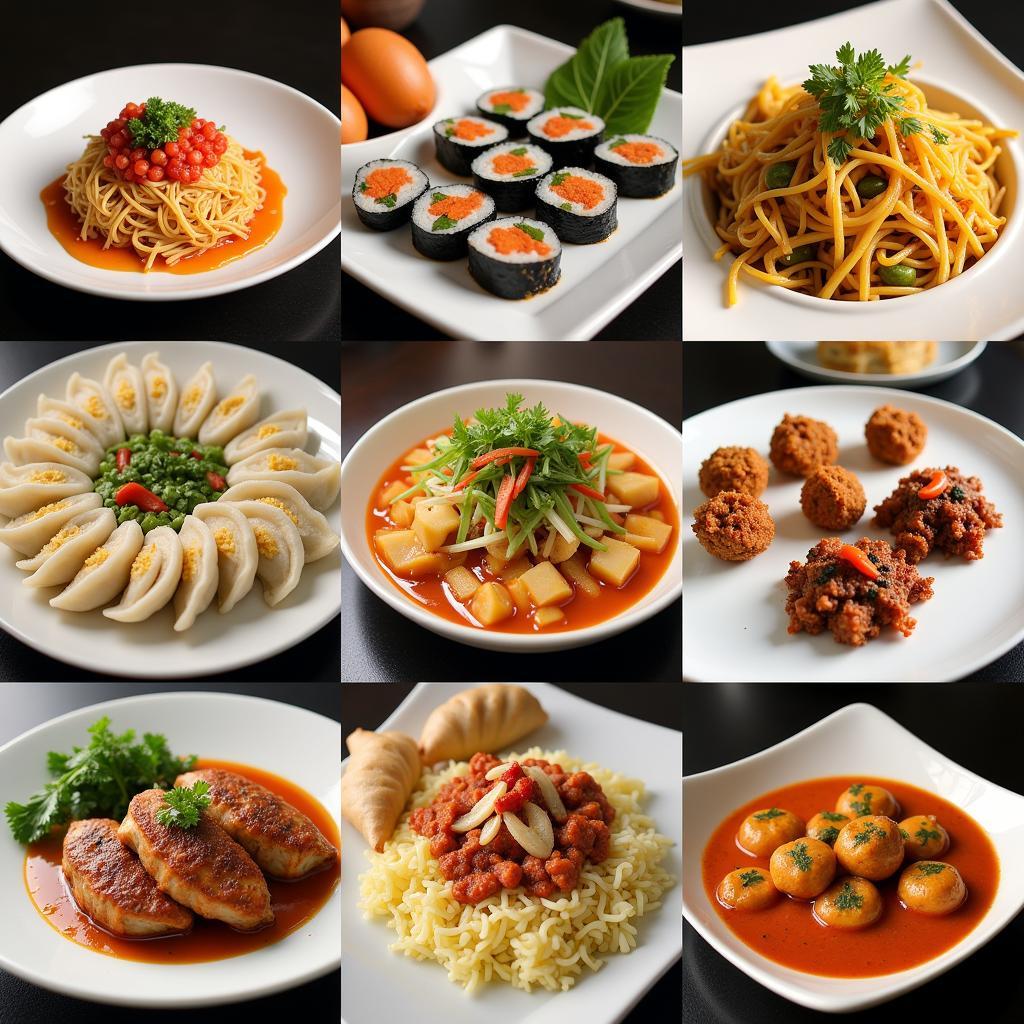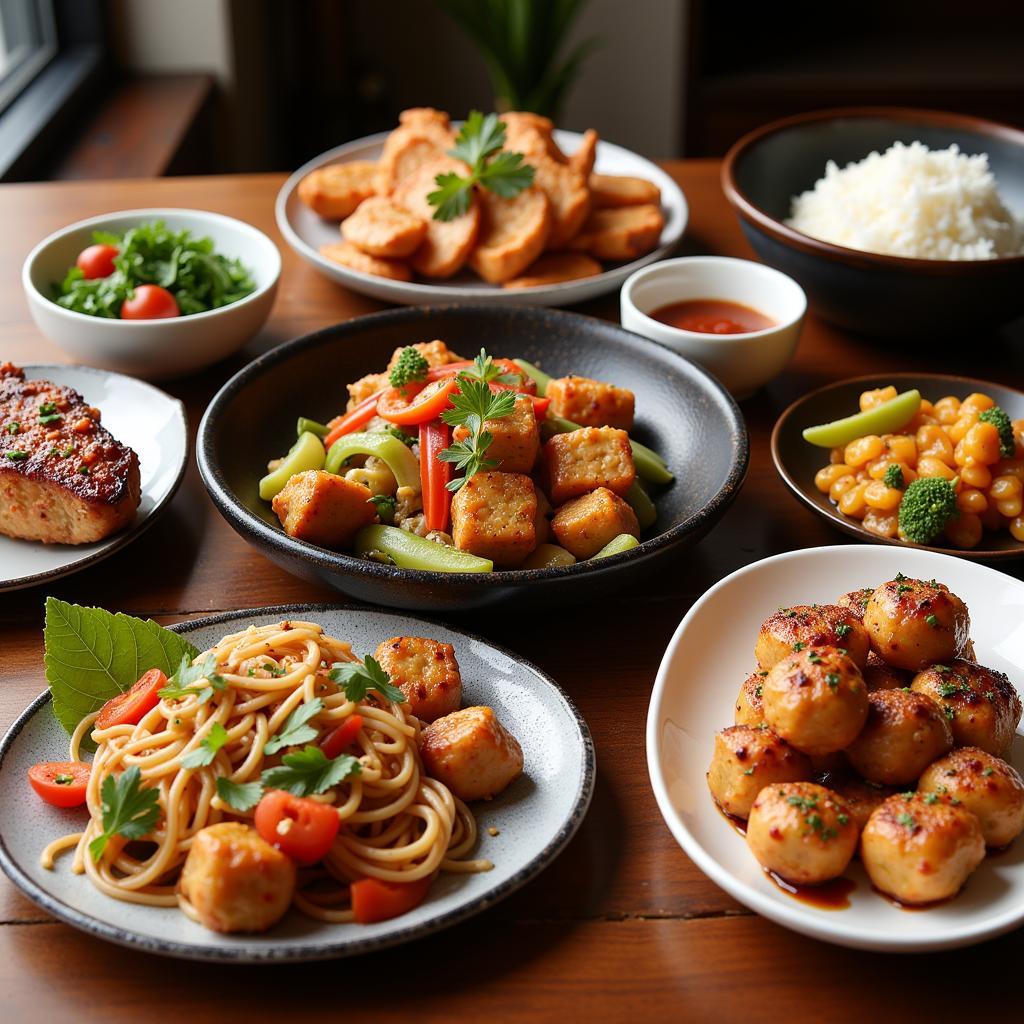Pan-Asian food, what is it exactly? It’s more than just a trendy term—it’s a vibrant culinary tapestry woven from the diverse flavors of East, Southeast, and South Asia. From the fiery spices of Thailand to the delicate nuances of Japanese cuisine, Pan-Asian cooking offers a captivating exploration of a vast and exciting culinary landscape. This article will unravel the mysteries of Pan-Asian cuisine, exploring its origins, key ingredients, and popular dishes. Get ready to embark on a delicious adventure!
Exploring the Origins of Pan-Asian Cuisine
Unlike traditional Asian cuisines rooted in specific geographic regions, Pan-Asian cuisine represents a fusion of culinary traditions. It’s a relatively modern concept, born from the increasing globalization and cultural exchange of the 20th and 21st centuries. This culinary melting pot allows chefs to borrow and blend ingredients and techniques from various Asian countries, creating innovative and exciting dishes that transcend national boundaries. Think of it as a celebration of Asia’s diverse culinary heritage, all on one plate.
While the exact origins are debated, the rise of Pan-Asian restaurants in major metropolitan cities worldwide played a crucial role in popularizing this fusion cuisine. These restaurants offered diners a taste of multiple Asian flavors in a single setting, sparking curiosity and appreciation for the vastness of Asian culinary traditions.
 Variety of Pan-Asian Dishes
Variety of Pan-Asian Dishes
Key Ingredients in Pan-Asian Cooking
What makes Pan-Asian food so unique? It’s the masterful blend of key ingredients, each contributing distinct flavors and aromas to create harmonious dishes. Common staples include:
- Soy Sauce: A fundamental ingredient providing a salty and savory base for many dishes.
- Ginger: A pungent rhizome adding a warm, spicy kick.
- Garlic: An aromatic bulb used extensively for its savory depth.
- Chili Peppers: Ranging from mild to fiery, chili peppers bring the heat and complexity to many Pan-Asian dishes.
- Rice: A staple grain served as a base for countless meals.
- Noodles: From thin rice noodles to thick udon noodles, they add texture and substance to soups, stir-fries, and other dishes.
These core ingredients are often combined with regional specialties like lemongrass, galangal, fish sauce, and various curry pastes, creating the signature flavors of Pan-Asian cuisine.
Popular Pan-Asian Dishes: A Culinary Journey
Ready to explore some of the most beloved Pan-Asian dishes? Here’s a glimpse into what awaits:
- Sushi (Japan): Vinegared rice topped with raw fish, vegetables, or other ingredients.
- Pad Thai (Thailand): Stir-fried rice noodles with shrimp, tofu, peanuts, and a tangy sauce.
- Kung Pao Chicken (China): A spicy stir-fry with chicken, peanuts, and vegetables.
- Ramen (Japan): A flavorful noodle soup with various toppings.
- Gyoza (Japan): Pan-fried dumplings filled with meat and vegetables.
 Popular Pan-Asian Dishes
Popular Pan-Asian Dishes
What Makes Pan-Asian Food So Appealing?
Why has Pan-Asian food captured the hearts (and stomachs) of so many? Its popularity stems from several factors:
- Flavorful and Diverse: The blending of different Asian cuisines offers a wide range of flavors and textures, satisfying a variety of palates.
- Accessible and Adaptable: Pan-Asian dishes are often easy to prepare and customize to individual preferences.
- Healthy and Fresh: Many Pan-Asian dishes incorporate fresh vegetables and lean proteins, making them a healthy and nutritious option.
Is Pan-Asian Food Authentic?
The question of authenticity often arises when discussing fusion cuisines. While Pan-Asian food may not adhere strictly to traditional recipes, it offers a unique and creative interpretation of Asian flavors. It’s a celebration of culinary innovation and cultural exchange, rather than a claim to absolute authenticity.
“Pan-Asian cuisine allows chefs to push boundaries and experiment with flavors,” says renowned chef, Anya Sharma, “It’s a dynamic and ever-evolving culinary landscape.”
 Fusion of Pan-Asian Ingredients
Fusion of Pan-Asian Ingredients
Conclusion: Embrace the Pan-Asian Food Experience
Pan-Asian food is more than just a collection of dishes; it’s a culinary journey through the vibrant flavors of Asia. From familiar favorites to innovative creations, there’s something for everyone to enjoy. So, next time you’re looking for a delicious and exciting culinary adventure, explore the world of Pan-Asian food.
FAQ
- What is the difference between Pan-Asian food and other Asian cuisines? Pan-Asian blends elements from multiple Asian countries, while traditional cuisines are specific to a region.
- Where can I find Pan-Asian restaurants? Many major cities have Pan-Asian restaurants. You can also find recipes online to create your own Pan-Asian dishes at home.
- Is Pan-Asian food spicy? The spice level varies depending on the dish and the chef’s interpretation. Many Pan-Asian dishes offer a balance of sweet, sour, salty, and spicy flavors.
- What are some common Pan-Asian cooking techniques? Stir-frying, steaming, and deep-frying are common cooking techniques used in Pan-Asian cuisine.
- What are some good vegetarian Pan-Asian dishes? Vegetable stir-fries, tofu curries, and vegetable spring rolls are popular vegetarian options.
- Is Pan-Asian food expensive? The price range varies depending on the restaurant and the dishes.
- Can I make Pan-Asian food at home? Absolutely! Many recipes are readily available online and in cookbooks.
Need further assistance? Contact us at Phone Number: 02437655121, Email: minacones@gmail.com or visit our address: 3PGH+8R9, ĐT70A, thôn Trung, Bắc Từ Liêm, Hà Nội, Việt Nam. We have a 24/7 customer support team.
Looking for more culinary inspiration? Check out our other blog posts on Vietnamese cuisine and Asian street food.